The ‘Gem State’ is indeed a gem for birdwatchers, with the Sage desert and the Northern Rockies as well to help ensure that a wide variety of environments are ready for the birds that love them. Today we will talk about the popular backyard birds of Idaho and tell you a little about some birds that you can see, where to look for them, as well as what they like to eat. We’ll top that off with some information on hotspots that you can visit in this state and give you some tips on creating the perfect feeder for attracting local birds. Let’s talk about those backyard birds of Idaho!
3 Categories – 432 Birds
With such an optimal range of environs Idaho is home to approximately 432 species of birds. While this is way too many birds for us to cover in the length of this article we will introduce you to a handful of birds that you can see. So that you know when to look for them we are going to divide them up like this:
- Year-round Resident birds
- Birds of Spring, Summer, and Early Fall
- Fall and Winter Birds
We’ll provide a sampling from each season and let you know where they like to hide as well as which foods are best to leave out in your feeder for attracting the specific types. The rest, of course, is up to those birds but with a little patience we think that you are going to have some excellent visits to your backyard feeder. Let’s get started with the long-term resident birds!
Idaho’s Year-round Resident birds
These birds have made Idaho their home and you can see them year-round, rain or shine, if you just know where to look. We’ve got you covered there so let’s start with the list so that you’ll have what you need. See if you can spot or lure these birds this year:
- Dark-eyed Junco
- Mourning Dove
- European Starling
- Downy Woodpecker
- Black-capped Chickadee
Dark-eyed Junco – Junco hyemalis

Coloration and Markings: While there will be a number of regional differences, the Dark-eyed Junco will typically be dark gray or brown on the upper portions of their bodies. This includes the back, the medium wings, and their long gray or dark brown tails which will evince white outer tailfeathers. The breast and the underbelly of this bird are white, however, it has a ‘vest’ of gray or dark brown flanking the white, which is thickest at the breast and thins out towards the underbelly. When the bird is standing still the effect is much the same as if it had waded in some white paint that coated the bottom 1/3 of the body. Facially, this bird has bird is gray with a stout, conical pink bill.
Size: These birds measure in at 5.5 – 6.3 inches in length and have wingspans of 7.1 to 9.8 inches.
Habitat: In the warmer months these birds spend a lot of their time in coniferous or miced-coniferous woods, though they will range (especially in winter) for foraging and end up in local parks, fields, and backyards with well-stocked feeders.
Diet: Cracked corn, Black Oil Sunflower seeds, and White Proso millet are all good choices for attracting the Dark-eyed Junco to your feeder.
Mourning Dove – Zenaida macroura
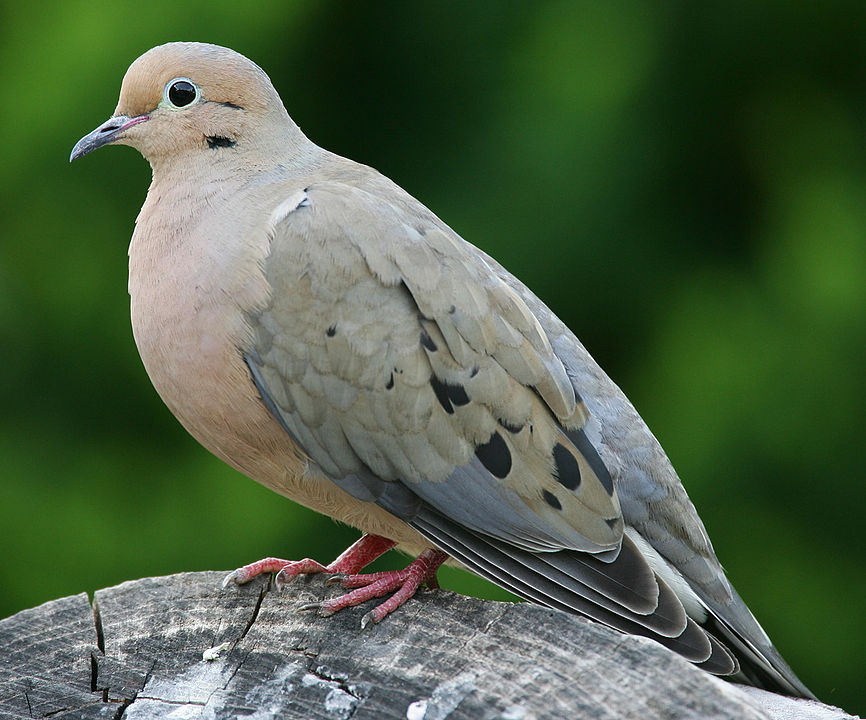
Coloration and Markings: Mourning Doves are typically gray or light brown with a healthy infusion of tan coloration. They have gray or brown backs and long wings, with the wings bearing a heavy concentration of creamy tan color and distinctive large, black spots at the center of the wings. They have long, pointy gray tails and the breast and underbelly will be a mix of white and creamy tan with pure white in small doses to flank these colors on the sides. Facially, this bird has a buffy-tan face with a thin white eyering and a medium-sized, straight black bill.
Size: These birds measure in at 9.1 – 13.4 inches from tip to tail and have wingspans of approximately 17.7 inches.
Habitat: Mourning Doves are city and town birds, eschewing the sidewalks to perch instead on phone lines, fences, and feeders. Watch for them on the sidewalks when you are in town, as these birds are not shy of the city at all.
Diet: Wheat, Black Oil Sunflower seeds, and cracked corn are favorites of the Mourning Dove. Stock up your feeder with these and you might make a new little friend!
European Starling – Sturnus vulgaris
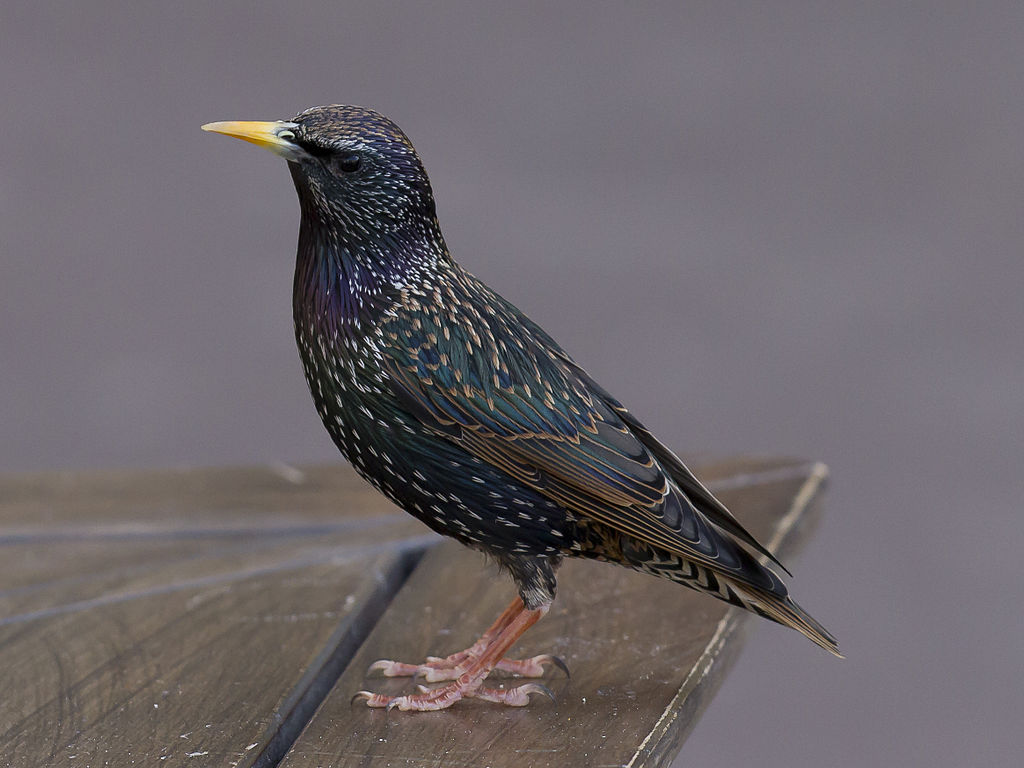
Coloration and Markings: The European Starling looks to simply be a blackbird with a big yellow bill if you are viewing it from a distance. Up close, you get a better look at the scintillating coloration. Their plumage is a mix of purple and greens and they wear this all over when it’s warm. This bird has a long, straight, and powerful yellow bill and in the winter it makes a dramatic color change – adopting brown plumage with white spots!
Size: These birds measure 7.9 – 9.1 inches from head to tail and have wingspans of 12.2 to 15.8 inches.
Habitat: These birds prefer towns and cities but they also like fields and farms. Look for them on fences and phone lines, scoping out their next meal and checking out what you’ve left for them in your backyard feeder.
Diet: These birds will eat a number of things, especially suet if you’ve got it. If they are hogging all the suet and you want to put a stop to it you can get Starling-proof feeders to protect your suet cakes and placate them as well with some wheat, oats, and dried or fresh berries.
Downy Woodpecker – Picoides pubescens
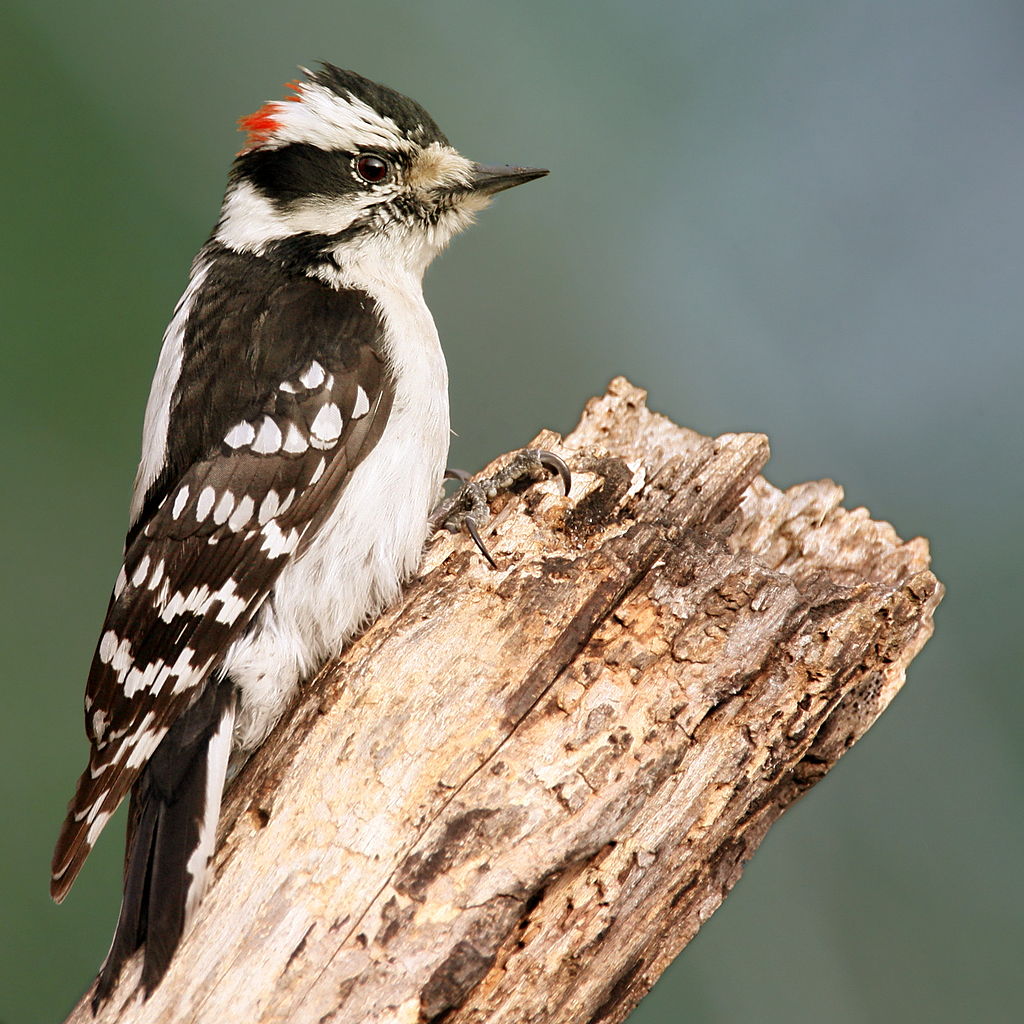
Coloration and Markings: Downy Woodpeckers have some lovely coloration. They have white backs with long, black wings which are decorated with white stripes, which are made up of white dots and give the wings a bit of a checkerboard look to them. They have short, split, black topped and white bottomed tails and the breast and underbelly of this bird are snowy white. Facially, these birds have white faces with some exceptions, such as a black mustache mark, a black mask, and a black stripe at the top of the birds’s head which will have a red spot towards the back if you are looking at a male Downy. These birds have thin, medium-length, and conical black bills.
Size: The smallest North American Woodpecker, these birds measure in at a mere 5.5 – 6/7 inches from tip to tail and have wingspans of 9.8 to 11.8 inches.
Habitat: Downies like the open woods, especially those of the deciduous variety. Weeds, brush, and brambles are also attractive to these little woodpeckers and they aren’t shy about ranging out to visit parks and backyards with well-stocked feeders.
Diet: Standard fare like suet and cracked corn can attract these little guys but if you really want to impress them, try breaking up some doughnuts and leave those out with some crunchy peanut butter. These birds have a big sweet tooth and they will be most thankful for your thoughtfulness.
Black-capped Chickadee – Poecile atricapillus
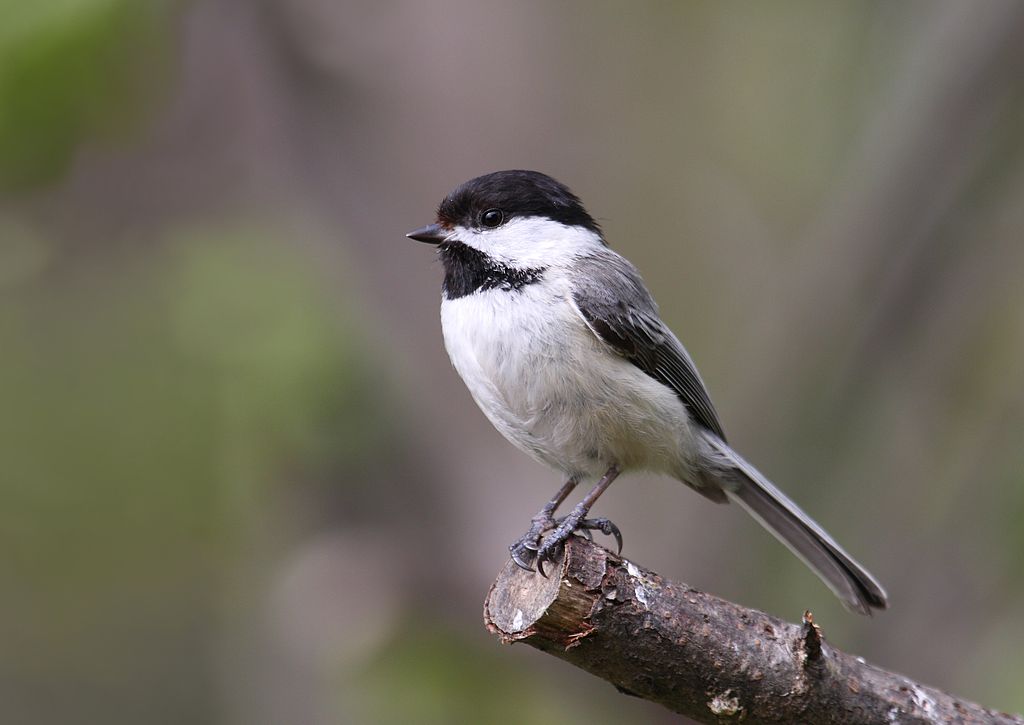
Coloration and Markings: Black-capped Chickadees have velvety gray backs with short gray wings that sport some minute white highlighting amongst the feathers. They have long, gray tails with white edging and the breast and underbelly of this bird are snowy-white with a light buff flanking visible at the sides, especially thick around the breast area. Facially, these birds have a large swathe of shite on the center of the face, combined with a small black bib below and a large, black cap above. This cap takes up most of the top of the face, terminating just at mid-eye level. These birds have tiny, conical black bills.
Size: These birds measure in at 5.7 – 5.9 inches in length with a wingspan of 6.3 to 8.3 inches.
Habitat: Marshes, fields, and woodlots… These birds like to go anywhere that there are trees and some handy brush or bramble cover to help them to feel safe.
Diet: Suet, Black Oil Sunflower seeds, and crunchy peanut butter are all great choices for attracting the Black-capped Chickadee to your backyard feeder.
Idaho’s Birds of Spring, Summer, and Early Fall
The rivers get louder, the ice and snow starts to go away, songbirds sing and the vineyards come to life… These are all sure signs that spring has arrived in Idaho and for the next few seasons you are going to be a busy birdwatcher. See if you can spot some of these birds in the warmer months either in your backyard or out on the town:
- Western Tanager
- Mountain Bluebird
- Lazuli Bunting
- Yellow-rumped Warbler
- American Goldfinch
Western Tanager – Piranga ludoviciana
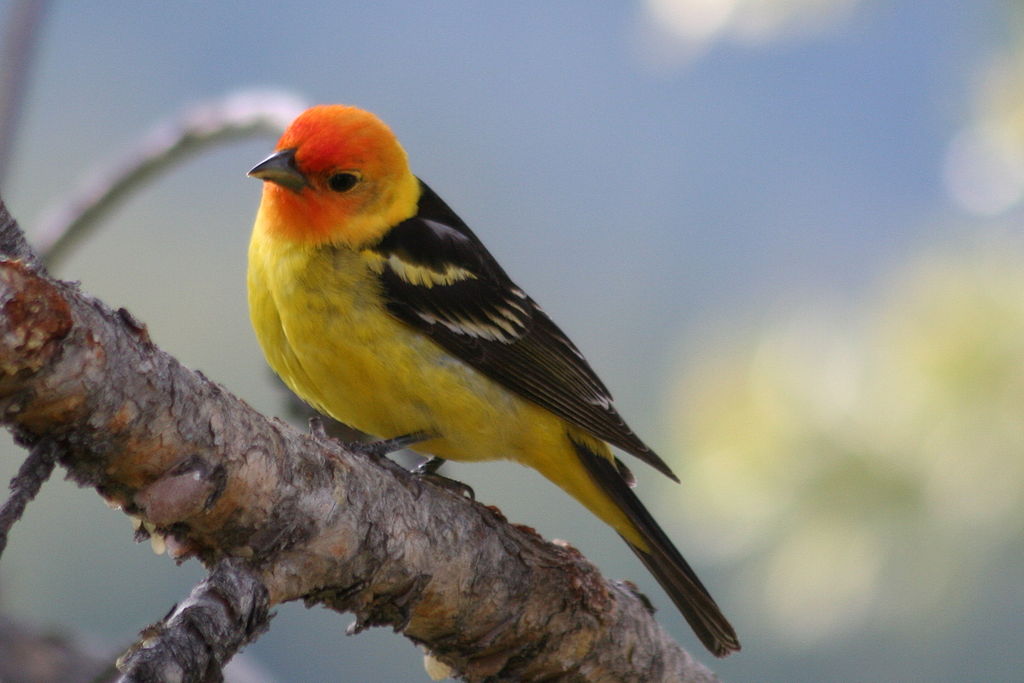
Coloration and Markings: Male Western Tanagers have black backs and medium-length black wings, with a yellow wingbar visible close to the shoulder and a white one following a little underneath. They have long, black-topped tails with yellow rumps and some yellow underneath the tailfeathers. The breast and underbelly of this bird are also yellow with a small amount of white peppered underneath the wings. Facially, these birds have pure yellow towards the back of the head while the rest of the face is yellow with heavy red saturation. They have medium-length, thick, conical brownish bills and the females will be colored a bit differently. Look for yellowish-green overall coloration and red which is situated predominantly at the front of the face. Juveniles, by contrast, won’t have any red except for tiny amounts which are visible in the Spring.
Size: These birds measure in at 6.3 – 7.5 inches with wingspans of approximately 11.5 inches in width.
Habitat: Junipers, Spruce, Pine, and Fir trees… these birds love coniferous forests when it’s warm. Look for them around these trees and at the occasional Oak. They are well worth the patience it takes to spot them!
Diet: While these birds will ignore seeds, you can attract them with a fresh-halved orange or even an assortment of dried fruits.
Mountain Bluebird – Sialia currucoides

Coloration and Markings: Male Mountain Bluebirds are quite striking, with sky-blue to turquoise backs, long blue wings and long tails to go with them. While you will sometimes see a little gray edging for the most part the upper body will be completely blue. They have white breasts and underbellies with some flanking at the breast of light blue mixed in the white. Facially, you might notice a thin, white eyering on this bird and it has a medium-length, straight, and thin black bill with some minimal curvature on the upper bill. Female Mountain Bluebirds will look quite different, being predominantly gray and brown with tints of blue in the wings and the tail and the occasional spot of orange-brown at the breast.
Size: These Bluebirds measure in at 6.3 – 7.9 inches in length with wingspans of 11 to 14.2 inches.
Habitat: Sagebrush, prairie, and even the icy tundra… these birds are most comfortable in wide-open areas at high and middle elevations where there is a bit of brush, bramble, or thorn cover nearby to help them to feel safe. They do visit backyards as well and can sometimes be tempted with nesting boxes, so if you’d like a Bluebird boarder then be sure to prepare accordingly and you might be pleasantly surprised!
Diet: Mealworms and berry vines are your best chance to attract Mountain Bluebirds. You can try adding fresh berries to your feeder as well if you don’t have fruiting vines or if you simply want to hedge your bets.
Lazuli Bunting – Passerina amoena

Coloration and Markings: Male Lazuli Buntings have blue backs and long, blue wings which have minute white edging, as well as some black accents, and a white shoulder patch above a white wingbar. Their long tails are blue above but white-edged and gray and black below. The rump of this bird is white, as is the breast and underbelly, however you will see a flanking on the sides starting from the underbelly of cinnamon which increases in width as it approaches the breast. Facially, the male is almost completely blue with the exception of black which goes from the upper bill and stops just in front of the eyes. These birds have medium-length, curved black bills. Females will be less colorful, being gray and brown with some blue tinting present and more cinnamon at the breast. They will also exhibit 2 buffy-tan wingbars. Juveniles will have a mix of tan and blue coloration on their backs and heads and the breast will bear more of a pumpkin, rather than cinnamon hue.
Size: These little birds measure in at 5.1 – 5.9 inches in length with wingspans of approximately 8.7 inches from wingtip to wingtip.
Habitat: Brush, thickets, brambles, and thorns… these birds love cover, so look for them in valleys with a bit of brush and next to streams, as they are also fond of areas near water. You can also spot them in overgrown fields and they are fond of gardens as well.
Diet: You can potentially attract the Lazuli Bunting to your backyard feeder with live mealworms and Nyjer Thistle.
Yellow-rumped Warbler – Setophaga coronata

Coloration and Markings: Yellow-rumped Warblers have gray backs with medium-length, gray wings. These wings will exhibit some black spots close to the shoulder as well as vertical white lines towards the center of the wings. Distinct yellow spots will also be present, one under each wing. They have long, thin gray tails which are black at the corners and while they have a white underbelly and rump the breast is only going to have white in the center, due to a heavy flanking of black spots forming a crude ‘vest’. Facially, this bird has a blue-gray face with a thin, white eyering and a small, bright-yellow bib. A small yellow spot is also sometimes visible on the crown and this bird has a medium-length, straight black bill. Females will have muted color, sometimes even showing some brown, and in the winter these birds will have their colors muted a bit as well though a yellow rump will still be evident.
Size: These birds measure in at 4.7 – 5.5 inches in length with wingspans of 7.5 to 9.1 inches.
Habitat: When it’s warm, these birds prefer coniferous and deciduous woods (in that order, actually) and they like open areas, so you can often spot them at the forest’s edge. They do also love parks and occasionally the coast if there’s some dense vegetation for hiding in.
Diet: Suet and Black Oil Sunflower seeds are a great temptation for these birds but if you really want to get their attentions, try adding a birdbath to the backyard. These guys can’t resist a little water to play in.
American Goldfinch – Spinus tristis

Coloration and Markings: The male American Goldfinch has a bright yellow back with long, black wings with some white markings you’ll definitely notice. These include a small wingbar at the shoulder, followed by a more readily visible one a little further down the wing. Towards the center of the wing you will notice some vertical white stripes and this continues to color the long, black tail so that the top is a mess of blacks and whites. The rump of this bird is pure white while the breast and the underbelly will be bright yellow. This yellow continues up into the face, where it is only interrupted by a small cap at the forehead which starts at the center of the top of the head and terminates at the bill. It almost looks like the bird is wearing a cap at a rebellious angle or like it’s gone out and gotten itself a toupee! These birds have medium-length, thick, conical orange bills and the females will display a duller yellow and sometimes even olive coloration. In the winter, both genders swap out their bright colors for the safety of non-assuming brown, but you can still spot them by their distinctive bills and by the 2 pale wingbars which are muted, but still quite present if you get a good look.
Size: These little birds measure in at 4.1 – 5.1 inches from tip to tail and have wingspans of 7.5 to 8.7 inches in width.
Habitat: These birds love areas with cover, such as weeds, brambles, thickets, and thorns. They also like to forage in flood-prone areas, so you can sometimes see them in fields or floodplains. They are happy to visit well-stocked feeders so be sure to leave a little something out for them.
Diet: The best mix to attract the American Goldfinch is said to be Nyjer thistle and Dandelion seeds. Give this a try and see what happens!
Idaho’s Fall and Winter Birds
Idaho gets a little icy in the winter, to say the least. With lows around -2 degrees Fahrenheit you will want a coat but surprisingly, there are a number of birds out there who don’t need one. Be sure to leave some snacks out for these tough winged wonders who will definitely be looking to see what is in your backyard when it’s chilly:
- Black-billed Magpie
- Snow Bunting
- Lapland Longspur
- Harris’s Sparrow
- Red-winged Blackbird
Black-billed Magpie – Pica hudsonia

Coloration and Markings: Black-billed Magpies have black backs, with a flanking of white ‘backpack stripes’, and they have long which appear blue and black completely when the bird is at rest but in flight you will notice that towards the tips of the wings they are white with black tips at about a 60/40 ration of blue vs. white. They have very long blue and black tails which fan nicely and have a central separation in flight and the while there is some white at the rump part of it and most of the underbelly are black, turning into pure white as the coloration moves up the breast. Facially, these birds are black, with the back-black giving the bird a bit of a ‘hooded’ appearance and these birds have long, powerful, straight black bills with some minor curvature on the upper bill.
Size: Roughly Crow-sized, these birds measure in at 17.7 – 23.6 inches in length with wingspans of 22.1 to 24 inches wide.
Habitat: These birds like to forage in towns, close to streams, and are often spotted in fields as well.
Diet: In the wild, Black-billed Magpies eat insects, eggs, and even carrion, but you can tempt them with Black Oil Sunflower seeds, mincemeat, and even bits of bread or pet food! While we don’t recommend the last two they are okay to use for ‘luring purposes’ in small amounts.
Snow Bunting – Plectrophenax nivalis

Coloration and Markings: Snow Buntings have a few variations in plumage though typically you are looking for a mostly-white bird, with a black back, and black wingtips on long, white wings which are white underneath as well. They have medium-length white tails and a white breast, underbelly, and face, and these birds have medium-length, conical black bills. Females will be mostly white but with brown streaking on the back when it’s mating season and at other times will display some rust color on the face and breast. Males, when not viewed during mating season will display a rusty orange at the shoulders, ear, and crown. The bills will turn a yellow-orange color on both genders when it’s not mating season.
Size: These birds measure in on average at 5.9 inches in length and have wingspans of approximately 11.8 inches.
Habitat: Rocky areas teeming with snow and ice are comfortable to this bird, which also frequents shorelines, fields, and general areas where weeds grow rampant and unchecked.
Diet: Snow Buntings are easy to please, just stock up on Nyjer thistle and they’ll happily munch to their heart’s content.
Lapland Longspur – Calcarius lapponicus

Coloration and Markings: Lapland Longspurs have black, brown, and white streaked backs and long wings with brown streaking and white edging. They have medium-length tails of the same color above but white underneath and the breast and underbelly of thie bird are white with black or brown streaking flanking lightly under the wings. Facially, this bird black in the front of the face which outlines the cheeks and extends below into the breast, and terminates just over the eye. The back portion of the face is white with a rust-spot towards the back of the neck, and the white curves up and over the eyes. The top of the bird’s head has a thick, black stripe and this bird has a stout, curved yellow bill which sometimes sports a black tip. In winter these birds become highly streaked and pale brown in color with dark, white-edged tailfeathers.
Size: This bird measures in at 5.9 – 6.3 inches in length and has a wingspan of 8.7 to 11.4 inches.
Habitat: These arctic tundra birds like to spend their time in the dunes along the coast, fields, and other open habitats.
Diet: These birds are fairly feeder-shy but you can try a mix of Nyjer thistle and hulled Black Oil Sunflower seeds. Use a ground feeder and scatter some seed around the base for best results.
Harris’s Sparrow – Zonotrichia querula

Coloration and Markings: Harris’s Sparrows have brown-streaked backs and medium-length wings which are also brown streaked with some black accenting and 2 thin, white wingbars. They have long, gray tails which are white underneath and while the breast and underbelly are mostly white there is some heavy brown streaking flanking the underbelly which becomes black streaking on the sides of the breast. Facially, this bird has a mostly gray face with a long, black bib, as well as black around the eyes, and a black crown. Juveniles will have black patches on the face rather than a more solid display and these birds have stout, medium-length, conical pink bills (which will sometimes have a black spot present).
Size: These birds measure in at 6.7 – 7.9 inches in length with wingspans of approximately 10.6 inches.
Habitat: Comfortable in the ice and snow, these birds are particularly fond of trees such as Willow, Alder, Black Spruce, and the Larch. They may also be found in pastures, fields, and yes, in backyards, so leave something out and you might just get a visit from these Canadian visitors.
Diet: Black Oil Sunflower seeds, White Proso millet, and cracked corn are 3 easy additions to make to your feeder if you’d like to attract the Harris’s Sparrow.
Red-winged Blackbird – Agelaius phoeniceus

Coloration and Markings: Red-winged Blackbirds are beautiful and easy to identify. Their backs are black with thin tracing patterns of red and yellow and their long, black wings bear red and yellow patches on the shoulder. When the bird is at rest, the red looks rather like a shark fin on top of a yellow and white ‘sea’ line. Aside from these marks, the bird is completely black and has a stout, sharp, and conical black bill. Females will have muted color on the breast and tend to be dark brown rather than black. They will also often display a white eyebrow line that can help you to identify them.
Size: These Blackbirds measure in at 6.7 – 9.1 inches in length with wingspans of 12.2 to 15.8 inches.
Habitat: These birds love to be around water, so look for them in marshes, fields, and even water traps on golf courses.
Diet: Black Oil Sunflower seeds and cracked corn are an easy combination which Red-winged Blackbirds will enjoy if you are thoughtful enough to leave it out for them.
Supporting cast (Other Backyard Birds of Idaho that might pay you a visit)
While they don’t have that fancy front page space, these ‘Supporting cast’ birds are year-round stars that are happy to visit your backyard and may be found in many different places when you are out and about in Idaho. See if you can spot one of these Supporting cast birds this year:
- Northern Flicker
- Song Sparrow
- House Finch
- American Robin
- Eurasian Collared-Dove
Northern Flicker – Colaptes auratus
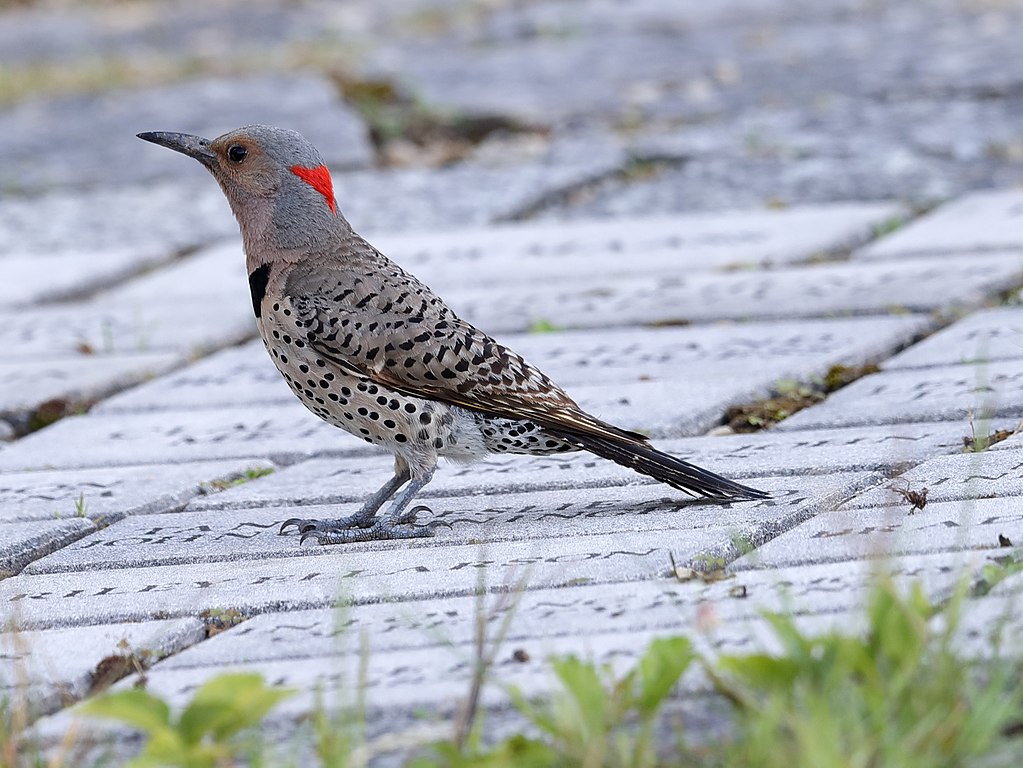
Coloration and Markings: Northern Flickers are large birds with brownish-grey bodies. Their long wings have brownish-gray banding with some black highlights and they have long, flared gray tails which are black edged and will be a bright yellow or a rich red underneath. The wings will also display red or yellow underneath when this bird is in flight. The breast and underbelly of this bird are gray with a little tan sometimes present, as well as some lovely and distinct black spots. A black crescent tops off the breast and above this is the Flicker\s long, gray neck. Facially, this bird is gray with a few distinct exceptions. You will see a red cheek line coming from the lower bill and terminating underneath the cheek and a small, rust colored mask which stops a little behind the eyes. This bird has a thin white eyering and a long, curved gray or black bill.
Size: These birds measure in at 11 – 12.2 inches in length with wingspans of 16.5 to 20.1 inches.
Habitat: These birds love open woods and the forest’s edge, though you can find them in deeper woods in the mountains. They do range out into parks and will visit your feeder if they see something they like, so be sure to prepare accordingly.
Diet: Suet cakes are simple and these birds love them, so be sure to leave a little out and you might just get the Northern Flicker’s attentions!
Song Sparrow – Melospiza melodia
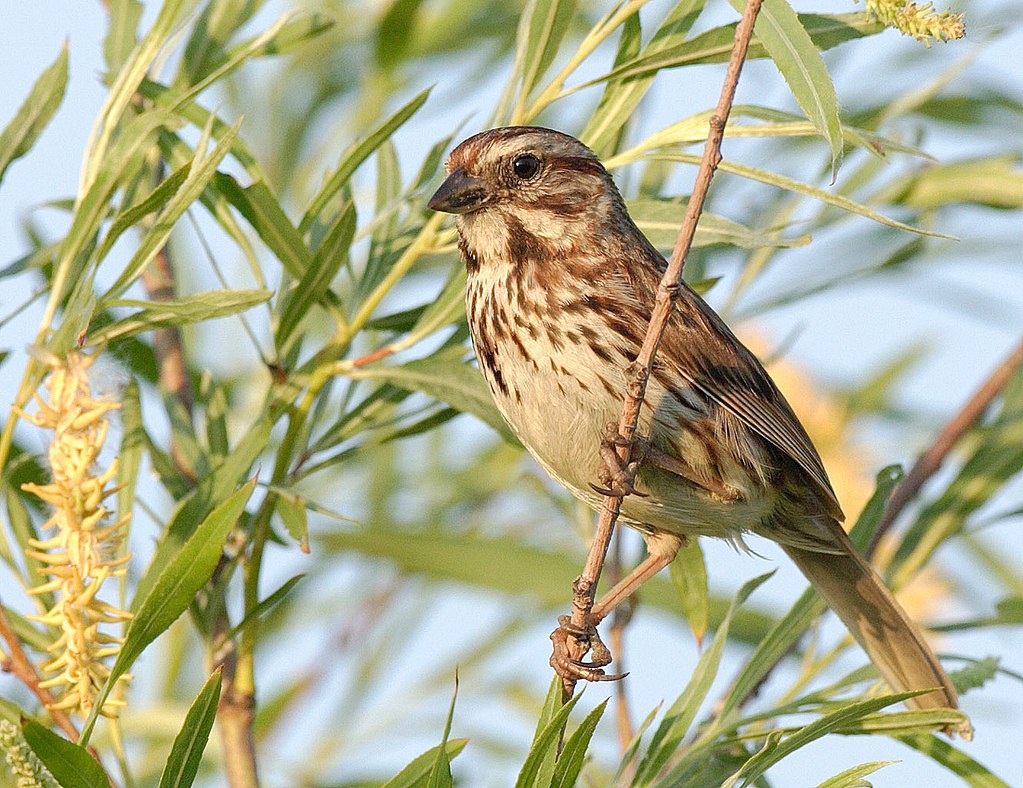
Coloration and Markings: Song Sparrows have brown-streaked backs with some gray present, with medium-length brown streaked wings with gray tips and long, perky brown tails. Their breast and underbelly are either gray or white with brown streaking present and facially these birds have mostly gray faces, with a white mustache line as an exception as well as a thin, brown mask and a rich, brown cap. They have short, stocky gray bills.
Size: These birds measure in at 4.7 – 6.7 inches in length with wingspans of7.1 to 9.4 inches.
Habitat: These birds love a wide variety of open environments, so you can see them at the edges of ponds and marshes, in weedy fields, and even in a desert wash. They are happy to visit parks and feeders in residential areas, so leave out something tasty and you might get a visit from a Song Sparrow.
Diet: Seeds and grains are what this bird eats in the wild, so leave out some hulled Black Oil Sunflower seeds, Nyjer thistle, and some wheat for good measure. These little guys will be happy that you did!
House Finch – Haemorhous mexicanus
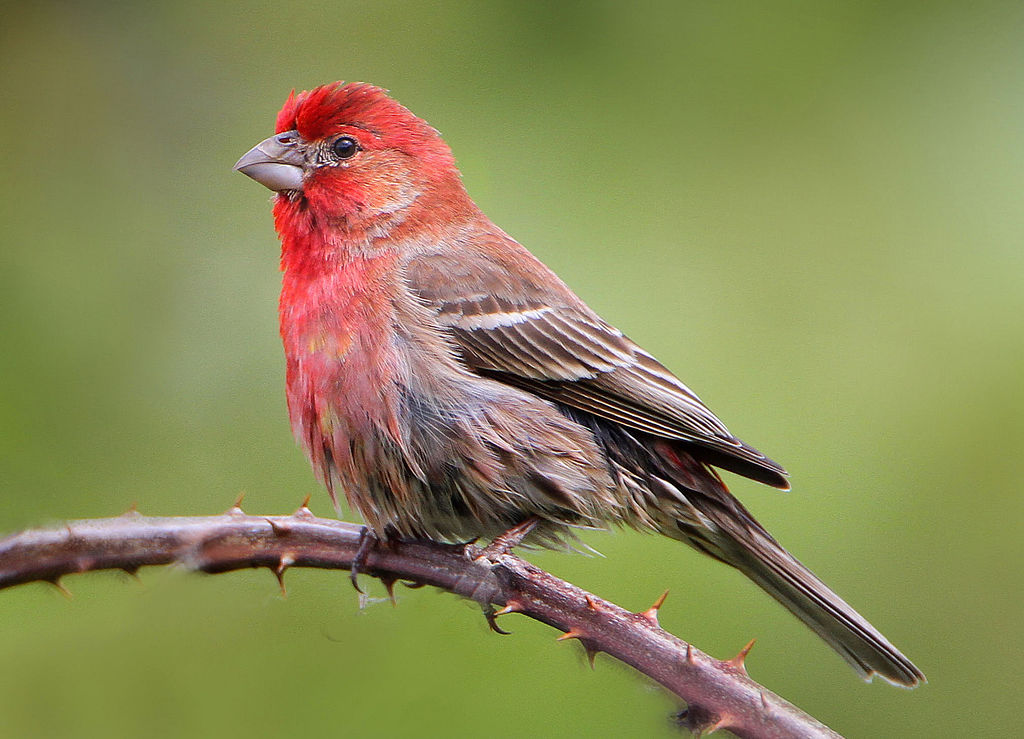
Coloration and Markings: House Finches have brown or gray backs with short wings which are gray or brown with some black banding. They have long gray tails with white on the sides and the underbelly will be white with dark streaking which gains a heavy saturation of rosy-red as the coloration moves up the breast to the heaviest red concentration. This red continues up into the face, highlighting the cheeks and stopping at the gray skin around the eyes, only to resurface above the eyes from the forehead to the back of the head, where it curls around to frame the cheek and terminates. These birds have stout, curved silver bills and the females will have a different coloration. They will be grayish-brown with some heavy streaking and lack the patterned marking displayed on the face of the males.
Size: These diminutive birds measure in at a mere 5.1 – 5.5 inches in length and have wingspans of 7.9 to 9.8 inches.
Habitat: When they aren’t at the forest’s edge, these birds are found at farms or inside cities. They are happy to visit a well-stocked backyard feeder.
Diet: While these birds will eat suet and even sometimes sample your Hummingbird feeder for a little sweetness, mixed fruits are your best bet with these birds.
American Robin – Turdus migratorius
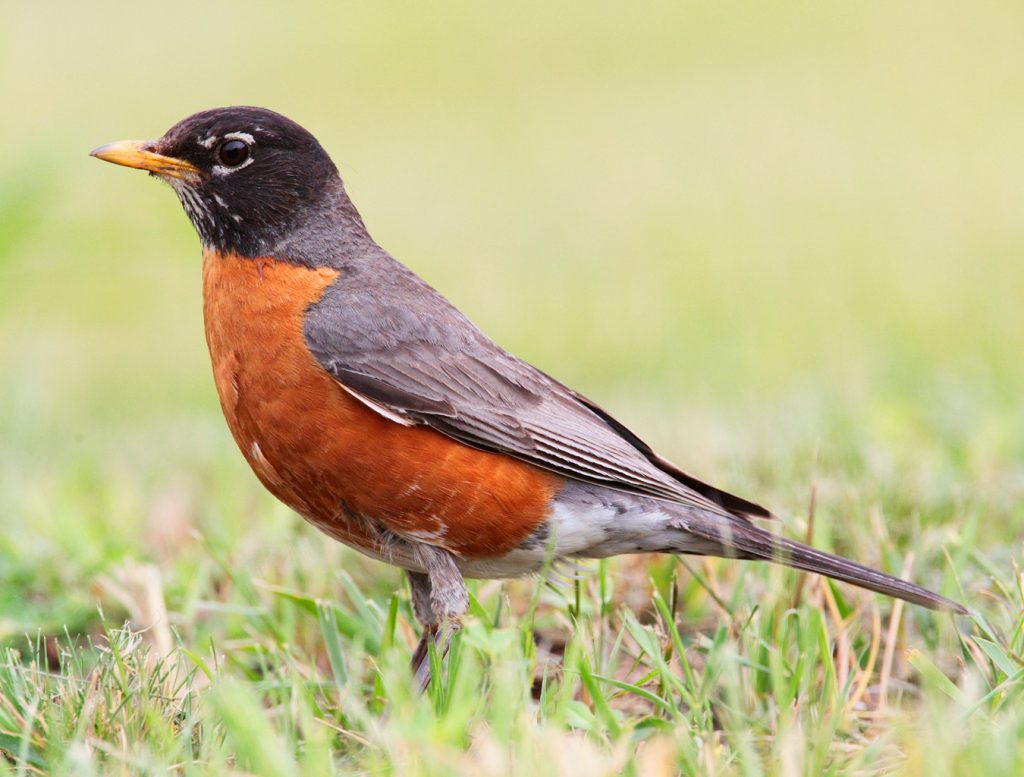
Coloration and Markings: American Robins have grayish-brown backs with long gray or brown wings and long gray-to-black tails with white undersides. This bird has a white rump and the breast and the underbelly are a smooth, lovely orange to orange-red color and facially, this bird has a black head with a minute amount of white underneath the bill and an eyering that looks like it was broken but completely encircles the eyes. These birds have medium-length curved yellow bills which sometimes have a black spot or two present. Female coloration is more muted and tends to run together rather than display the contrast of colors seen in the male.
Size: These birds measure in at 7.9 – 11 inches in length with wingspans of 12.2 to 15.8 inches in width.
Habitat: When they are in the woods they prefer deciduous areas but beyond this you can see a Robin just about anywhere. Golf courses, parks, backyards.. Keep an eye out, these birds aren’t shy!
Diet: These birds love mealworms but if you don’t have any handy, try some soft fruits like cut up ripe pear or peaches.
Eurasian Collared-Dove – Streptopelia decaocto
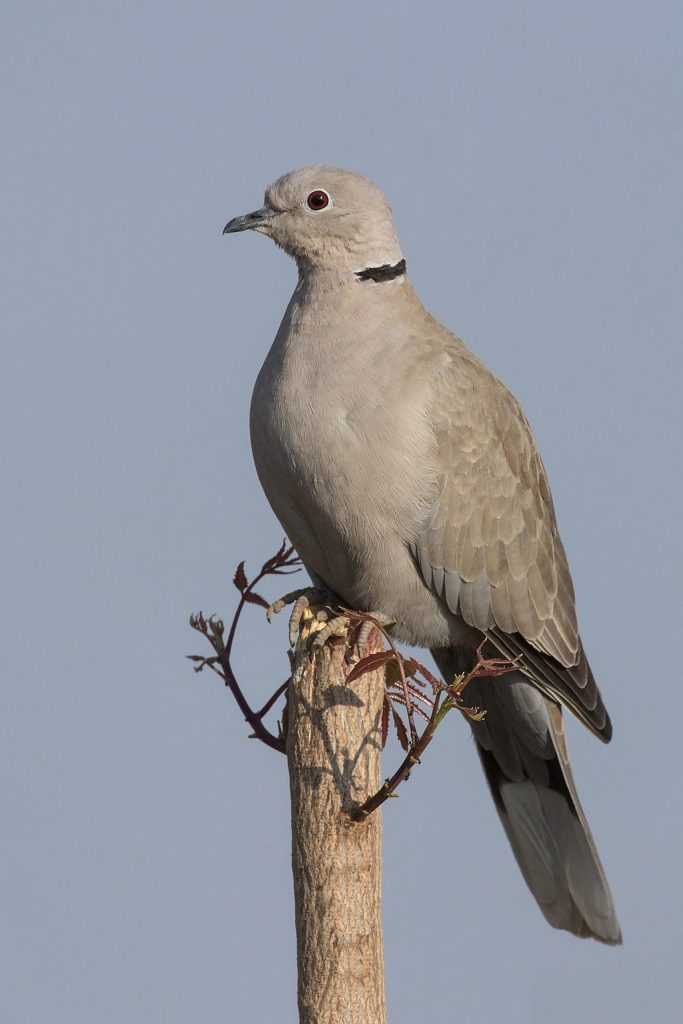
Coloration and Markings: Eurasian-collared Doves are gray to buff-gray all over their bodies with a few exceptions. They have long gray wings with black tips and long, gray tails which are minutely white tipped at the ends and often bear white patches. The breast and underbelly tend to be a creamy buff color and a black crescent is present at the base of the bird’s long, light-gray neck and rather resembles a Celtic torque ring. Facially, this bird is typically light gray with a thin white eyering and a medium-length straight black bill which displays minor curvature on the upper bill.
Size: These birds measure in at 11.4 – 11.8 inches from head to tail and have wingspans of approximately 13.8 inches.
Habitat: These birds are not people-shy and rather than spending their time in the woods they are found in farms and cities.
Diet: Cracked corn, milo, White Proso millet, and Black Oil Sunflower seeds will score some points with this bird once it notices that you have left them out.
Idaho Bird Buffet
The Idaho Department of Fish and Game has some advice regarding your bird feeders which includes some suggestions for popular food items that you can stock. We’ve thrown in some recommendations of our own as well and if you’d like to see the original article (which includes some cleaning and other tips as well) then be sure to check our reference section where you’ll find a link. In the meantime, try adding some of these items to your feeders:
- Black Oil Sunflower seeds
- Nyjer thistle
- Suet
- Cracked corn
- Grape or Strawberry jelly
Idaho Birding Hot Spots
If you want to get some photos of your favorite feathered stars in their natural environment like a true Chirparazzo then you are in luck. We’ve got some hotspots that you can visit which are located all over the state. If you don’t find something close to home then just check our references and you can view the entire list. Be sure to take a little time-off this year and try a little birding in one of these sweet spots:
- Northern hotspot – Route of the Hiawatha
- Eastern hotspot – Idaho Falls Greenbelt
- Southern hotspot – Snake River Canyon Rim Trail
- Western hotspot – Weiser River National Recreation Trail
- Central hotspot – Wood River Trail
Detailed descriptions of each location as well as information regarding visiting and what birds you can see at these locations may be found at https://www.traillink.com/stateactivity/id-birding-trails/
Final Thoughts
Well folks, that concludes our brief exploration into the wonderful world of birding in the ‘Gem State’ of Idaho. Remember above all that a birder must be patient and use the tips which we have provided to set up some feeders full of temptation and before you know it you might just have some beautiful new visitors. We wish you the best of luck in your birding, you are definitely in a great state for it!
